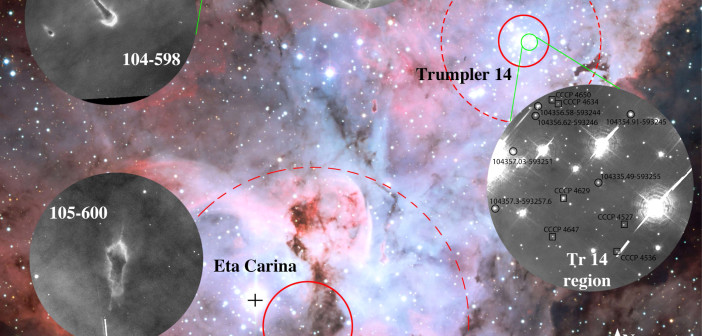Can protoplanetary disks form and be maintained around low-mass stars in the harsh environment of a highly active, star-forming nebula? A recent study examines the Carina nebula to answer this question.
Crowded Clusters
Stars are often born in clusters that contain both massive and low-mass stars. The most massive stars in these clusters emit far-ultraviolet and extreme-ultraviolet light that irradiates the region around them, turning the surrounding area into a hostile environment for potential planet formation.
Planet formation from protoplanetary disks typically requires timescales of at least 1–2 million years. Could the harsh radiation from massive stars destroy the protoplanetary disks around low-mass stars by photoevaporation before planets even have a chance to form?

Artist’s impression of a protoplanetary disk. Such disks can be photoevaporated by harsh ultraviolet light from nearby massive stars, causing the disk to be destroyed before planets have a chance to form within them. [ESO/L. Calçada]
Turning ALMA Toward Carina
A perfect case study for exploring hostile environments is the Carina nebula, located about 7500 lightyears away — and home to nearly 100 O-type stars as well as tens of thousands of lower-mass young stars. The Carina population is ~1–4 Myr old: old enough to form planets within protoplanetary disks, but also old enough that photoevaporation could already have wreaked havoc on those disks.
Due to the dense stellar populations in Carina’s clusters, this is a difficult region to explore, but the Atacama Large Millimeter-submillimeter Array (ALMA) is up to the task. In a recent study, a team of scientists led by Adal Mesa-Delgado (Pontifical Catholic University of Chile) made use of ALMA’s high spatial resolution to image four regions spaced throughout Carina, searching for protoplanetary disks.
Detections and Non-Detections

Two evaporating gas globules in the Carina nebula, 104-593 and 105-600, that each contain a protoplanetary disk. The top panels are Hubble images of the globules; the bottom panels are ALMA images of the disks detected within them. [Mesa-Delgado et al. 2016]
Equally important: Mesa-Delgado and collaborators failed to detect any indication of disks in the core of Trumpler 14, a cluster in Carina that is home to some of the most massive and luminous stars in the Galaxy. This non-detection suggests that the particularly harsh environment of Trumpler 14 is too brutal for disks within it to survive.
These observations provide new clues as to where we should be looking to study planet formation: less dense regions in star-forming nebulae seem to be locations that can support giant-planet-forming disks, whereas the harsh radiation fields of especially dense subclusters seem to cause the rapid destruction of such disks.
Citation
A. Mesa-Delgado et al 2016 ApJ 825 L16. doi:10.3847/2041-8205/825/1/L16


1 Comment
Pingback: destroying and creating protoplanetary disks in the Carina nebula